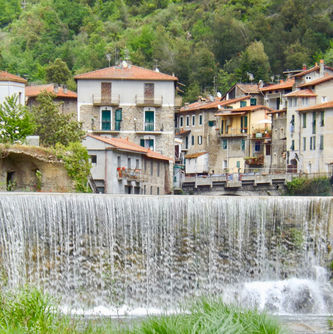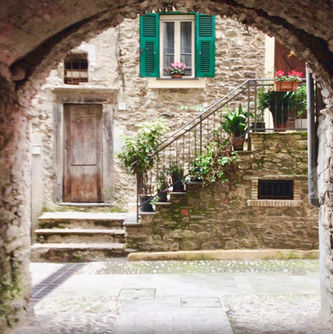
Isolabona is known throughout Italy for its excellent quality olive oil, the altitude just correct to make the perfect oil. Italians come from far and wide to the Cassini oil shop over the bridge on the way to Pigna.
Local food stores in the village, eggs from the local free range chickens and the little patisserie shop bake all their own pastries and cakes. The grocery shop is superb, to call it a delicatessen makes them seem contrived and sound French. Vegetables directly from local gardens of the village, bread baked daily from the bakery. The gorgonzola a triumph of humanity. Post office, chemist, butcher, seamstress & hairdresser. Gorganzola and walnut sausages from the hands of the master. The beef from their own farm is most excellent.
Wine Rossesse is the red. Pigato is the white. The DOGC limits three valleys, centered here in the village. There are several winemakers and wine made in the passagios. Prince Albert on his recent visit took away bottles of the most excellent local wine Castiglian, made right here in the passagios by young wine makers Carlotta and Lucca. You will not find a lot about Pigato or Rossesse wine in the books about how to woffle about wine, because it is nearly all drunk right here.
Liguria has a wonderful mix of sea and hill, reflected in the menu. Isolabona close enough to the sea to get very fresh fish and in the hills enough to have cattle that are multisource organic grazing. Taken to the high mountain pastures for the summer. Does this affect the taste. Yes, it does. The Ligurians take authenticity of ingredient and of the cook of great importance. There are very local ways to cook snails, white Pigna beans, stuffed courgette flowers, or the most excellent and light courgetti and mixed veg flan with parmesan sauce. But there are also Calabrian kitchens who give a wonderous journey south into the world of the peporonchino. Close to the border the Italians have guarded their Tarte Verde receipes with guile. All I can tell you is the veg must be home grown in the gardens of the village. Nona makes the tarte at home takes to the Deli, where it is cut up, and yes you can buy it, so do so! Take it home heat it up as you need a snack. Deep strongly held discourse in the bars, not about football, but about recipes.(held in dialect).
This is the best of Italy.
The gourmet's treasure trove.


In the North-West Coast of Italy in Liguria, just ten minutes from the French border, the warm Mediterranean waters are on your doorstep as well as the foot of the Ligurian Hills.
Rock Pools Beach Ventimiglia Menton Monaco Monte-Carlo San Remo Nice Airport
5 mins 20 mins 20 mins 20 mins 30 minutes 40 minutes 45 minutes
Isolabona (the beautiful island) is an ancient settlement at the end of two long valleys on two rivers. One stretching back to Monte Tauragio which makes the backdrop. The alp closest to the Mediterranean. The village is the gateway to a vast wildness of hills rolling up to the Alps in one direction and the sea in the other. This mountain/sea world has influenced the receipes and cooking styles. It is possible to find excellent fish dishes and the fruits of the forest a large diversity of fungi fresh from the woods and wild boar. Seasonality is key. Mushroom time will see locals disappearing into the hills with large wicker baskets. These will be turned into one night offers in the local caffes, bars and restaurants. Trompette delle Morte linguini my favourite. This is the very best of Italy. The gourmet's treasure trove.
The buttressed 14th century passagios (ancient passages) that go to make up the streets of the village (known as the comune) will be a little bewildering to start with. The lack of traffic in the centre ensures a safe area for kids to go feral. The locals are friendly with a pleasing mix of diversity. Check the tree posters for local food or wine festivals, or events cycle, vintage car, motorcycle races etc. There has been human settlement here since before the bronze age. The Grimaldi (nee Dora) castle guarding this important T junction.


The historical and close tie to the ground is still very evident in and around Isolabona. This a working Italian village with more of the income coming from the ground than from tourism. Yet close to the gilded streets of Monaco and the French Riviera.
The previous owner of No 8 via Orsini would leave the village every Monday to spend the week at the farm in the family hills, to return on Friday for a weekend in the village. There is a culture for many almost most families to make their own Olive Oil from their own trees.
Isolabona shares a geographical location with Pigna, Dolce Aqua and Apricale, but also sharing a dialect and a Grimaldi history.
I was told in no uncertain terms the Romans conquered England, but they only ever passed through here.
The piratical history reflected by the stone skull and cross bones on the front of the pirates church in neighbouring Vallecrosia.
Frescoes in the old church, not the one in the piazza are important Ligurian art history.
The fountain in the main drag has been flowing non-stop since 1482. Cyclists often seen filling their water bottles.












































